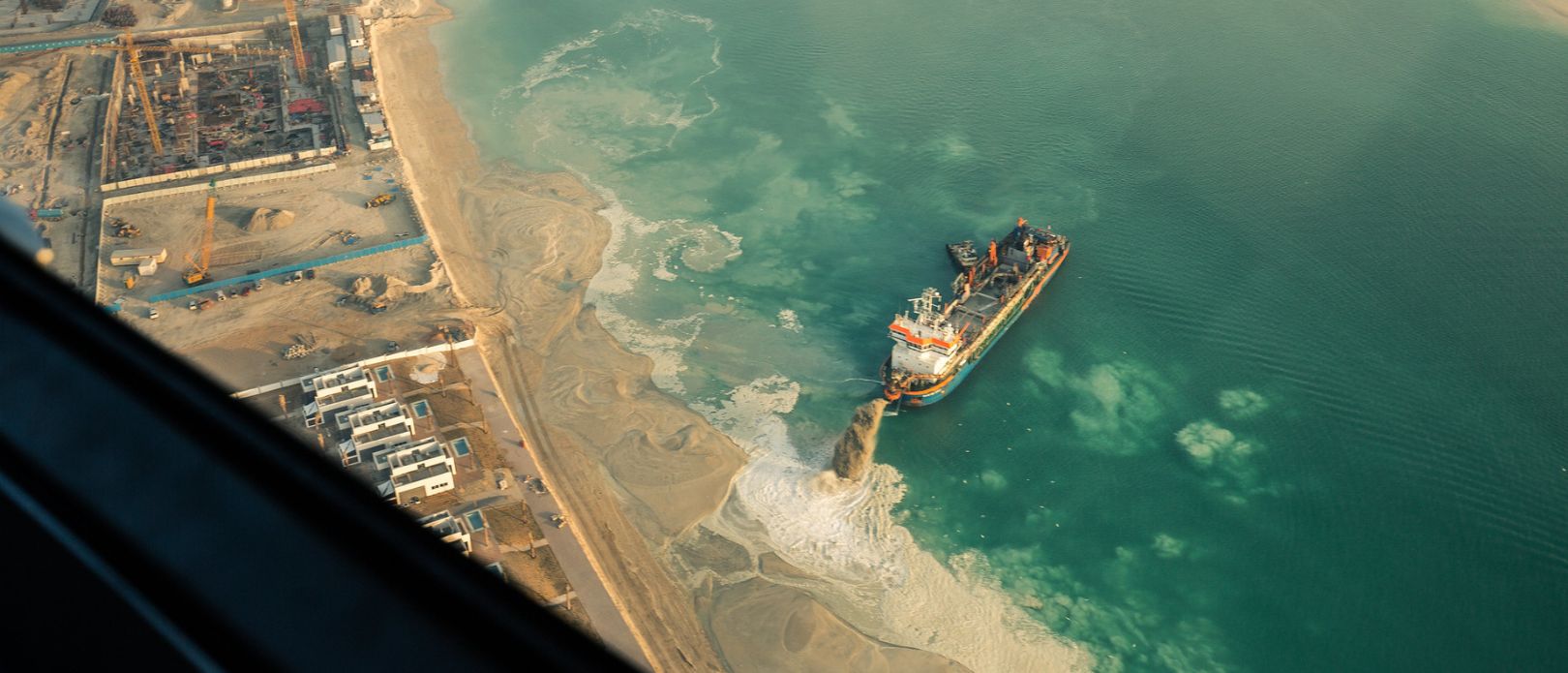UN Ocean Conference 2022
Sand extraction: the biggest resource crisis you’ve never heard about
Sand is the world’s most exploited mineral but little is known about the industry behind it
- Over the last 20 years, the consumption of sand and gravel has increased threefold globally
- Natural aggregates, such as sand and gravel, are today the most mined minerals in the marine environment
- There is only very limited monitoring of how much sand is extracted from where and by whom
We sat down with centre researcher Jean-Baptiste Jouffray to talk about the most overlooked building block of the Anthropocene.
Jean-Baptiste, why do we need to care about sand?
Sand is a resource that is flying under the radar, particularly when it comes to sustainability and equity. It’s used all over the world, but we have very limited transparency on where it’s coming from.
Because of industrialisation and certainly because of increased urbanisation, the demand for sand is booming. Over the last 20 years, the consumption of sand and gravel has increased threefold globally.
Sand is not a renewable resource, at least not at the human scale.
Are we going to run out of it then? Isn’t the Sahara Desert full of sand?
We can’t really use desert sand because of the grain shape. It has a particular wind-weathered shape that prevents it from binding and that makes it pretty much unusable for construction projects.
What you need is more angular grain. You can find that in the beds of rivers and lakes, on beaches, in land quarries, and from the seafloor – the latter being mostly used for land reclamation projects.
When it comes to the scarcity issue, it is important to distinguish between a global and a local scale. I don’t see that we are going to exhaust all sand resources on the planet any time soon. What we’re seeing already though are local scarcity issues.
What are the risks when we’re mining sand?
Extracting it comes with impacts, but the types of impact are very different depending on where you are sourcing it. For land quarries, you would deforest the area and essentially mine it, but impacts are going to be contained to that space. It is considered an inactive sand deposit.
Rivers and beaches, on the other hand, are active and dynamic sources of sand, there it’s moving all the time. Those flows can have crucial importance for ecosystems and the communities who depend on them, not just at the point of extraction but also downstream.
There is of course always some sort of direct habitat destruction and loss of biodiversity.
And if you dredge sand from the marine environment, you get a whole array of other impacts as well: These range from turbidity plumes – imagine huge dust clouds under water; they block light that organisms rely upon – to beach erosion by reducing the sediment supply to the coast, damages to archaeological sites, and threatened livelihoods of coastal communities such as fisheries and tourism activities.
How much sand is extracted from the ocean?
We really don’t know. There is only very limited monitoring of how much sand is extracted from where and by whom.
What we can see is that as land quarries and river beds become depleted, there is a growing interest in ocean sand resources. Natural aggregates, such as sand and gravel, are today the most mined minerals in the marine environment.
When it comes to ocean sand there are very different scales of extraction. On one hand, you have a highly consolidated dredging industry with a few big companies dominating the market. On the other hand, you have a lot of small-scale, often undocumented, unregulated or even illegal extraction of sand. This can be just people mining the beach with shovels.
There are a number of cases where this extraction has fallen into the pitfalls of criminality.
In several instances illegal sand mining has been linked to civilian death, particularly in India, where these practices have become so organized that people speak of it as a “sand mafia”.
What needs to be done to make our use of sand sustainable?
The United Nations Environmental Programme, UNEP, has just released a report entitled “Sand and Sustainability: 10 strategic recommendations to avert a crisis”. The first one is to raise awareness for the issue and recognize sand as a strategic resource. Then we need to include place-based perspectives – who benefits from the extraction and who doesn’t in a given environmental, social, political and economic context. Their third recommendation is to enable a paradigm shift to a circular future. It’s one thing to make extraction sustainable, but it’s another to try to use less and look for alternatives.
Further recommendations include among others the need for stronger governance and better monitoring, national standards, and ensuring the restoration of degraded ecosystems.
What is the Stockholm Resilience Centre doing on the topic of sand?
Together with Jan Kuiper and two colleagues at Stanford University, Rafael Schmitt and Colette Wabnitz, we have received a FORMAS Grant to develop a systemic understanding of the interlinked socio-economic, ecological and geological dimensions associated with sand. This fall we will be hiring a PhD student to really lead this process.
Within our work with the Ocean Risk and Resilience Action Alliance (ORRAA), we’re also co-hosting an official side event at the UN Ocean Conference to put sand on the ocean sustainability agenda and identify promising opportunities for stewardship.
One of the deliverables is to produce a scoping report on ocean sand that will be released in early fall.

Jean-Baptiste Jouffray is a postdoctoral researcher exploring what the Anthropocene means for the ocean, what it entails for how we study marine social-ecological systems and, essentially, what can be done to improve sustainability.
His research involves inter- and transdisciplinary approaches, ranging from the Hawaiian archipelago and indicators for effective coral reef management to the global seafood industry, the role of transnational corporations, and whether there could be entry points for sustainability considerations into mainstream financial mechanisms.

.jpg)







